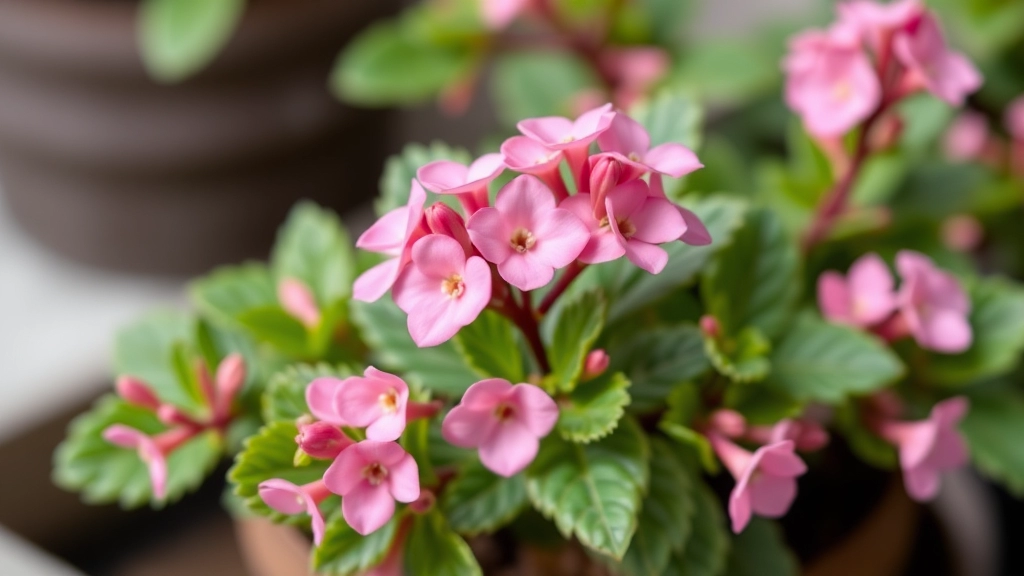Guide to Growing the Pink Kalanchoe Plant
Looking to add a splash of colour to your indoor garden? The Pink Kalanchoe Plant is a fantastic choice. Known for its vibrant blooms and easy maintenance, this succulent is perfect for both novice and seasoned gardeners. In this guide, I’ll walk you through everything you need to know about growing, caring for, and maintaining your Pink Kalanchoe Plant, ensuring it thrives and brightens up your space.
Ideal Conditions for Your Pink Kalanchoe
First things first, let’s talk about the ideal conditions for your Pink Kalanchoe. This plant loves bright, indirect sunlight and well-draining soil. Overwatering is a common mistake, so make sure to let the soil dry out between waterings. With the right care, your Pink Kalanchoe will reward you with stunning blooms that can last for weeks.
Care Tips
Stick around as we delve into more detailed care tips, from propagation to pest control, to keep your plant in top shape.
Are you struggling to keep your Pink Kalanchoe thriving? Understanding the best conditions for these vibrant plants can make all the difference.
## Ideal Temperature and Humidity
Pink Kalanchoe plants flourish in warm environments.
– **Temperature**: Aim for a range between 18°C to 24°C (65°F to 75°F).
– **Humidity**: They prefer moderate humidity levels.
## Light Conditions
Bright, indirect sunlight is key.
– **Direct Sunlight**: Too much can scorch the leaves.
– **Low Light**: Insufficient light can hinder blooming.
## Air Circulation
Good airflow is essential for preventing diseases.
– **Placement**: Avoid cramped spaces.
– **Ventilation**: Ensure your plant has enough breathing room.
## Watering Needs
Overwatering is a common mistake.
– **Soil Dryness**: Allow the top inch of soil to dry out before watering again.
– **Drainage**: Make sure your pot has drainage holes to prevent root rot.
For more detailed care tips, check out our [complete guide to pink Kalanchoe plant care](https://planthq.org/complete-guide-to-pink-kalanchoe-plant-care/). Additionally, if you’re curious about other varieties, explore our [top Kalanchoe varieties with pink edges](https://planthq.org/top-kalanchoe-varieties-with-pink-edges/).
How to Water and Fertilize Pink Kalanchoe
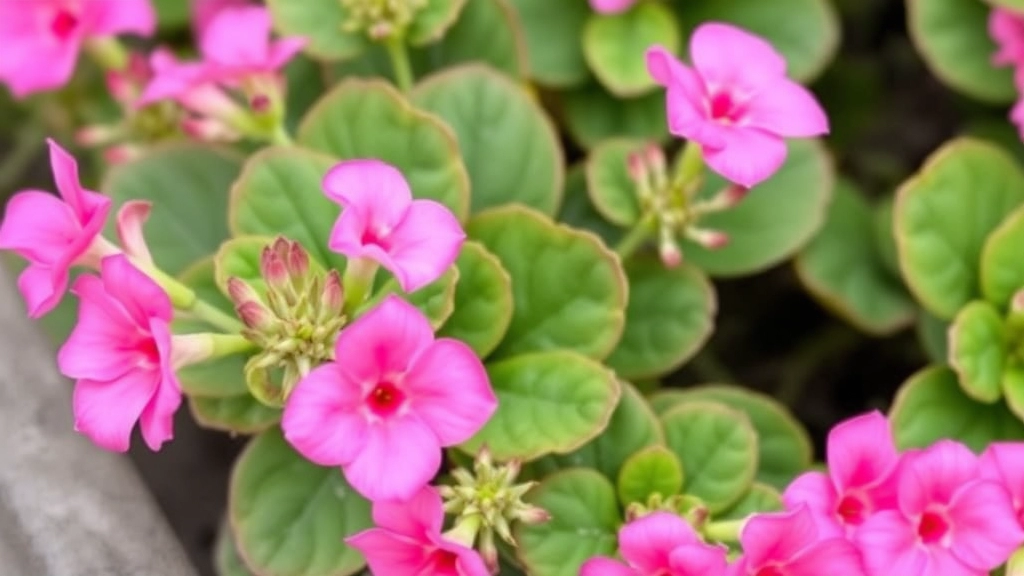
So, you’ve got your beautiful Pink Kalanchoe, and now you’re probably wondering how to keep it thriving. Watering and fertilizing are key to ensuring your plant stays vibrant and healthy.
Watering Tips for Pink Kalanchoe
- Check the Soil: Before you water, poke your finger about an inch into the soil. If it feels dry, it’s time to give it a drink.
- Watering Method: When you do water, do it thoroughly. Let the water run through the drainage holes at the bottom of the pot. This ensures the roots get enough moisture.
- Frequency: Generally, watering every 2-3 weeks works well. In the winter, you can cut back even more since the plant goes dormant.
- Signs of Overwatering: Yellowing leaves or a mushy stem? That’s your plant telling you it’s had too much water.
Fertilizing Your Pink Kalanchoe
- Type of Fertilizer: Use a balanced, water-soluble fertilizer. Look for something with equal parts nitrogen, phosphorus, and potassium (like a 20-20-20 mix).
- When to Fertilize: Feed your Kalanchoe every 4-6 weeks during the growing season (spring and summer). Skip the fertilizing in the fall and winter.
- How Much: A diluted solution is best. Follow the instructions on the fertilizer package, as it can vary.
- Signs of Under-Fertilization: If your plant’s growth seems stunted or the blooms are sparse, it might be time to up your fertilizing game.
Sunlight Requirements for Vibrant Blooms
When it comes to nurturing your Pink Kalanchoe, understanding its sunlight needs is crucial for achieving those stunning blooms. Many plant enthusiasts often wonder how much light their Kalanchoe truly requires.
Ideal Soil and Potting Tips for Kalanchoe
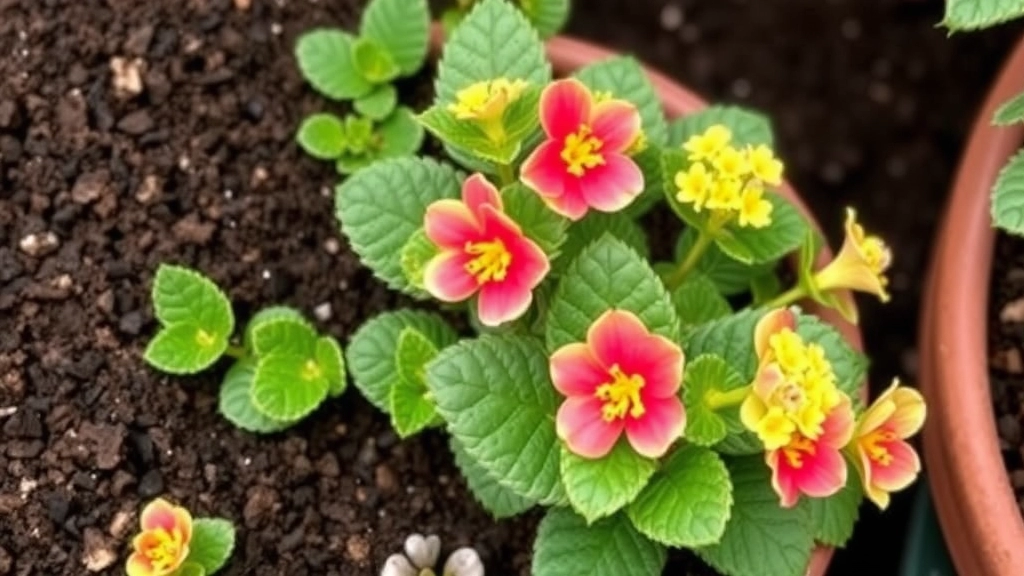
When it comes to growing Pink Kalanchoe, the right soil and potting techniques can make all the difference. Are you wondering what type of soil is best for your Kalanchoe?
Choosing the Right Soil
Pink Kalanchoe thrives in well-draining soil. Here are some essential tips:
- Cactus Mix: A commercial cactus or succulent mix is perfect. It provides the drainage your plant craves.
- DIY Mix: If you prefer a homemade option, combine:
- 1 part potting soil
- 1 part perlite
- 1 part sand
- pH Level: Aim for a slightly acidic to neutral pH (around 6.0 to 7.0).
Potting Tips
The pot you choose is just as crucial as the soil. Follow these guidelines:
- Drainage Holes: Always select pots with drainage holes to prevent root rot.
- Size Matters: Choose a pot that is one size larger than the current one. Kalanchoe prefers being slightly root-bound.
- Repotting: Aim to repot every couple of years to refresh the soil and promote healthy growth.
Additional Considerations
- Watering After Potting: Water your Kalanchoe lightly after repotting to help settle the soil.
- Timing: The best time to repot is in spring, just as the growing season begins.
Propagation Methods: Cuttings and Offsets
Are you looking to expand your collection of pink Kalanchoe plants?
Propagation is a rewarding way to do just that.
There are two primary methods for propagating Kalanchoe: cuttings and offsets.
Cuttings
Taking cuttings is a straightforward process. Here’s how to do it:
– **Choose a Healthy Stem:** Select a healthy, mature stem from your Kalanchoe.
– **Make the Cut:** Using clean, sharp scissors, cut a section of the stem about 10-15 cm long.
– **Let it Callous:** Place the cutting in a dry, shaded area for a few days. This allows the cut end to callous over, which helps prevent rot.
– **Planting:** Once calloused, plant the cutting in well-draining soil. Water lightly.
– **Care:** Keep the soil slightly moist and place it in indirect sunlight until roots develop.
Offsets
Offsets are small plants that grow at the base of the main plant. They can be easily separated and replanted. Here’s how:
– **Identify Offsets:** Look for small rosettes or plantlets around the base of your Kalanchoe.
– **Remove Carefully:** Gently twist or cut the offset away from the main plant, ensuring some roots are attached.
– **Replant:** Plant the offset in a small pot with well-draining soil.
– **Water and Care:** Water lightly and place it in a warm, bright location.
Both methods can lead to thriving new plants, allowing you to share or expand your indoor garden. For more detailed steps, you might want to check out this [step-by-step guide on propagating Kalanchoe leaves](https://planthq.org/how-to-propagate-kalanchoe-leaves-a-stepbystep-guide/). Additionally, if you are interested in growing different varieties, the [complete guide to growing Kalanchoe Pink Butterflies](https://planthq.org/complete-guide-to-growing-kalanchoe-pink-butterflies/) is a great resource.
Common Pests and How to Handle Them
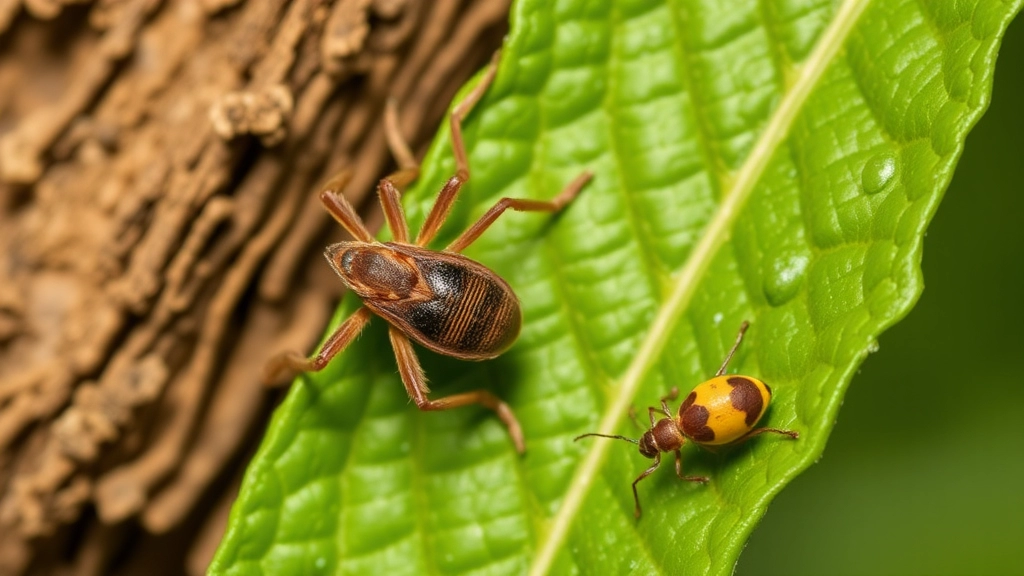
So, you’ve got your lovely Pink Kalanchoe thriving, but what happens when those pesky pests decide to crash the party?
Identifying Common Pests
First off, let’s chat about the usual suspects:
- Aphids: Tiny green or black bugs that suck the sap from your plant. You might notice yellowing leaves or a sticky residue.
- Mealybugs: These look like little cotton balls. They hide in leaf joints and can cause a lot of damage if left unchecked.
- Spider Mites: Super tiny and often go unnoticed until you see webbing on your plant. They thrive in dry conditions.
Quick Fixes
Here’s how to tackle these uninvited guests:
- Inspect Regularly: Make it a habit to check your Kalanchoe every week. Early detection is key!
- Soap Solution: Mix a few drops of dish soap with water in a spray bottle. Give your plant a good misting to knock off pests. Rinse it off after a couple of hours.
- Neem Oil: This is a natural insecticide. Just mix it with water and spray it on your plant. It’s safe and effective.
- Isolate Affected Plants: If you notice pests, move the affected plant away from others to prevent spreading.
- Keep It Clean: Wipe down the leaves regularly to remove dust and any lurking pests.
Prevention is Key
To keep those pests at bay, consider these tips:
- Proper Watering: Avoid overwatering, as damp conditions attract pests.
- Good Air Circulation: Ensure your plant has enough airflow around it. This makes it less inviting for pests.
- Healthy Soil: Use well-draining soil to keep your plant robust and less vulnerable.
How to Encourage Re-Blooming of Pink Kalanchoe
After understanding the best conditions for your Pink Kalanchoe, you may wonder how to coax it into producing those stunning blooms again.
Understanding the Bloom Cycle
Pink Kalanchoe typically flowers in cycles. To encourage re-blooming, you need to mimic its natural environment and care routine.
Key Tips for Re-Blooming
- Light Control:
- Reduce light exposure to about 12 hours a day.
- Use a dark period of 12-14 hours to simulate winter conditions.
- Temperature Management:
- Keep the plant in a cooler environment, ideally between 15-20°C during the night.
- Avoid placing it near heat sources or drafty windows.
- Watering Routine:
- Allow the soil to dry out between waterings.
- Water sparingly to prevent root rot, which can hinder blooming.
- Pruning:
- After the initial flowering, trim back spent blooms and any leggy growth.
- This helps redirect energy into new flower buds.
- Fertilizing:
- Use a balanced, water-soluble fertilizer every 4-6 weeks during the growing season.
- Switch to a low-nitrogen fertilizer once buds appear to promote flowering.
- Rest Period:
- Allow your Kalanchoe a rest period of 6 weeks after blooming.
- During this time, reduce watering and refrain from fertilizing.
Real-Life Example
I once had a Kalanchoe that refused to bloom again. After a little research, I adjusted its light exposure and gave it a good prune. Within weeks, I noticed new buds forming. It was a rewarding experience that transformed my plant into a vibrant spectacle once more.
For more detailed guidance, check out this step-by-step guide on how to get Kalanchoe to bloom and learn about the causes and solutions for brown spots on Kalanchoe leaves to ensure your plant stays healthy.
Tips for Repotting and Maintaining Plant Health
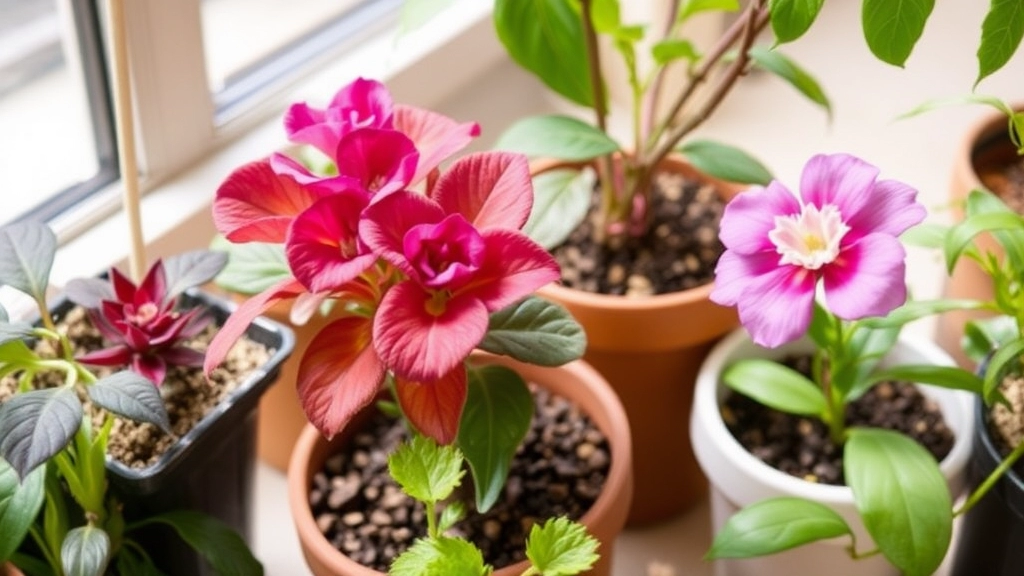
So, you’ve got your Pink Kalanchoe thriving, and now you’re thinking about repotting.
When Should You Repot?
- If you notice roots poking out of the drainage holes.
- If the soil dries out too quickly.
- If the plant seems top-heavy or unstable.
Repotting Steps:
- Choose the Right Pot:
- Go for a pot that’s one size larger than the current one.
- Ensure it has drainage holes to prevent waterlogging.
- Prep the New Soil:
- Use a well-draining cactus or succulent mix.
- You can also mix regular potting soil with sand or perlite for better drainage.
- Remove the Plant Carefully:
- Gently squeeze the pot to loosen the roots.
- Tilt the pot and slide the plant out, supporting the base.
- Trim Damaged Roots:
- If you see any mushy or brown roots, snip them off.
- Place in New Pot:
- Position your Kalanchoe in the centre of the new pot.
- Fill in with fresh soil, leaving a little space at the top.
- Water Sparingly:
- After repotting, wait a week before watering.
- This helps the roots settle without the risk of rot.
Maintaining Plant Health:
- Light: Keep it in bright, indirect sunlight. Too much direct sun can scorch the leaves.
- Watering: Water only when the top inch of soil feels dry. Overwatering is a common mistake.
- Fertilizing: Feed with a balanced liquid fertilizer every 4-6 weeks during the growing season.
Common Signs of Stress:
- Yellowing leaves? It could be overwatering.
- Wilting? Check for underwatering or pests.
Seasonal Care: Adapting to Indoor and Outdoor Growth
As we delve into seasonal care, it’s essential to consider how to adapt your Pink Kalanchoe for both indoor and outdoor environments. This will ensure your plant thrives throughout the year.
Understanding Seasonal Changes
Indoor Growth:
- Winter Care:
- Keep your Kalanchoe in a warm spot, ideally between 15-20°C.
- Reduce watering frequency as the plant enters dormancy.
- Spring Awakening:
- As temperatures rise, gradually increase watering.
- Consider repotting if the plant has outgrown its current pot.
Outdoor Growth:
- Summer Sunshine:
- Place your Kalanchoe in a location that receives bright, indirect sunlight.
- Water more frequently, ensuring the soil dries out between sessions.
- Autumn Transition:
- Prepare your plant for cooler temperatures by bringing it indoors if necessary.
- Cut back on fertiliser to allow the plant to rest before winter.
Key Tips for Seasonal Adaptation
- Temperature Awareness:
Keep an eye on temperature fluctuations, especially when transitioning between indoor and outdoor environments. For more detailed advice, check out our Kalanchoe Blossfeldiana Indoor vs Outdoor Care Guide.
- Humidity Control:
Indoor environments can be dry, especially in winter. Consider using a humidity tray or misting occasionally. Learn more about maintaining optimal conditions in our Optimal Care for Kalanchoe Blossfeldiana Growth.
- Light Adjustments:
If moving your Kalanchoe outdoors, gradually acclimatise it to prevent sunburn.
FAQs About Pink Kalanchoe Plant
How often should I water my Pink Kalanchoe?
Generally, watering every 2-3 weeks works well. In the winter, reduce the frequency as the plant goes dormant. Always check the soil first; if it feels dry an inch below the surface, it’s time to water.
What type of fertilizer should I use for my Pink Kalanchoe?
Use a balanced, water-soluble fertilizer with equal parts nitrogen, phosphorus, and potassium (such as a 20-20-20 mix). Feed your Kalanchoe every 4-6 weeks during the growing season (spring and summer).
What kind of soil is best for Pink Kalanchoe?
Pink Kalanchoe thrives in well-draining soil. A commercial cactus or succulent mix is ideal. Alternatively, you can create a DIY mix using 1 part potting soil, 1 part perlite, and 1 part sand.
How do I know when to repot my Pink Kalanchoe?
Repot if you notice roots poking out of the drainage holes, if the soil dries out too quickly, or if the plant seems top-heavy or unstable. The best time to repot is in spring.
What are common pests that affect Pink Kalanchoe, and how can I handle them?
Common pests include aphids, mealybugs, and spider mites. Inspect your plant regularly, use a soap solution or neem oil for treatment, and isolate affected plants to prevent spreading. Keeping the plant clean and ensuring good air circulation can help prevent infestations.
How can I tell if my Pink Kalanchoe is overwatered?
Signs of overwatering include yellowing leaves and a mushy stem. Ensure your pot has drainage holes and allow the soil to dry out between waterings to avoid overwatering.
What should I do if my Pink Kalanchoe’s growth seems stunted or the blooms are sparse?
This could be a sign of under-fertilization. Consider feeding your plant with a balanced, water-soluble fertilizer every 4-6 weeks during the growing season.
What are the ideal light conditions for Pink Kalanchoe?
Pink Kalanchoe prefers bright, indirect sunlight. Too much direct sun can scorch the leaves, so place it in a spot where it gets plenty of light without being exposed to harsh, direct rays.
How should I handle my Pink Kalanchoe after repotting?
After repotting, water the plant lightly to help settle the soil. Wait about a week before watering again to allow the roots to adjust and minimize the risk of rot.
What are some common signs of stress in Pink Kalanchoe?
Common signs include yellowing leaves, which may indicate overwatering, and wilting, which could be due to underwatering or pests. Regularly check your plant’s soil moisture and inspect for pests to keep it healthy.
References
-
How to Care for a Kalanchoe Plant
-
Growing Kalanchoe Indoors
-
Kalanchoe
